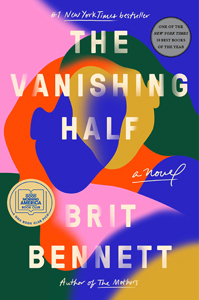 Brit Bennett, The Vanishing Half: A Novel (New York: Riverhead, 2020), 343pp.
Brit Bennett, The Vanishing Half: A Novel (New York: Riverhead, 2020), 343pp.
Brit Bennett is officially two for two. When The Vanishing Half was released on June 2, 2020, it debuted at the #1 spot on the NYT fiction best-seller list, where it has remained ever since. Within a month, HBO acquired the rights for a limited television series based on the book with Bennett as executive producer. The novel was also included on at least 25 "best of the year" lists. Bennett's first novel, The Mothers (2016), was likewise a best-seller, and was similarly acquired in 2017 by Warner Brothers for a film adaptation.
The Vanishing Half begins in a rural Louisiana town called Mallard, whose distinction is that it was founded in 1848 as a place for light-skinned blacks "who would never be accepted as whites but refused to be treated like Negroes." It was a third space between whites and blacks, it was "colorstruck," and "obsessed with lightness." White people could not believe it existed, while blacks gossiped about the "uppity" light-skinned residents.
The identical twins Stella and Desiree epitomized Mallard's ideal. They had creamy skin "the color of sand barely wet," hazel eyes, and wavy hair. But the similarity ended there. The novel begins when the girls run away from the small world of Mallard at the age of sixteen. Desiree returned fourteen years later, but to the shock of the locals, "where nobody married dark," she had married "the darkest man she could find. . . In Mallard, nobody married dark. . . Marrying a dark man and dragging his blueblack child all over town was one step too far.” Stella's daughter Jude was "jet black. . . as black as tar." In school Jude was ridiculed as "Tar Baby," "Midnight," "Darky" and "Mudpie." It was a hard life for Stella to stay in Mallard and care for her mother Adele, while Jude left for a new beginning at UCLA.
Stella was "the color of clabber," and nearly mugged one time as "a white bitch." Unlike Desiree, Stella never returned home; she did something far more radical. She "decided to become someone else," that is, "she decided to become someone white." She "passed over" and lived a "split life." She even tried to prevent a black couple from moving into her rich LA neighborhood. It was hard work to "maintain the lie that was your life." She even hid her past from her white husband. Like Desiree, she also had a daughter, but whereas Jude was jet black, Stella's daughter Kennedy was blonde haired and blue-eyed. Nonetheless, the lives of those two very different cousins would eventually collide.
Some of the most powerful forces that shape us are ones over which we have little to no control—nature, nuture, geography, history, and culture. Add to that destiny and personal choices, and you have a mysterious melange that shapes one's personal identity. Bennett's novel moves beyond colorism as a proxy for racial identity to include all of these factors. It's a powerful story, and you can easily imagine how it would make a marvelous HBO drama.
Dan Clendenin: dan@journeywithjesus.net


